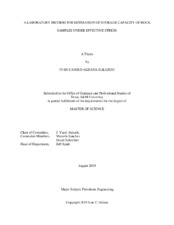A Laboratory Method for Estimation of Storage Capacity of Rock Samples Under Effective Stress
Abstract
Fluid storage capacity measurement of core-plugs in the laboratory considers pore-volume as a function of effective stress. The latter is equal to (Applied Confining Pressure) – (Effective Stress Coefficient) x (Applied Pore Pressure). However, results are often reported as a function of difference in the applied pressures, because the effective stress coefficient is unknown and depends on the mechanical properties of the sample. This creates confusion during the interpretation of laboratory data and leads to added uncertainties in the analysis of storage. In this study I present a new laboratory method that allows simultaneous prediction of the sample pore volume, coefficient of isothermal pore compressibility, and the effective stress coefficient. These quantities are necessary to predict the fluid storage as a function of effective stress. The method requires two stages of gas (helium) uptake by the sample under confining pressure and pore pressure and measures pressure-volume data. Confining pressure is always kept larger than the equilibrium pore-pressure but their values at each stage can be changed arbitrarily. The method considers gas leakage adjustments at high pore pressure. The analysis is simple and includes simultaneous solutions of two algebraic equations including the measured pressure-volume data. The model is validated at zero stress. The reference volume predicted at zero stress matches with that measured independently using the standard helium porosimeter. For sandstone and shale, the pore compressibility is on average 1x10-5 psi-1 and the effective stress coefficient is slightly higher than unity. The effective stress coefficient in isotropic elastic porous materials is known as the Biot’s coefficient and the value we predict indicates the relationship between the bulk and grain volume moduli. Interestingly the effective stress coefficient predicted using shale samples rich in clays and organic matter is slightly higher than that for sandstone. This indicates other features of the sample such as fine-scale texture (laminations, and anisotropy, etc.) could come into play during the fluid storage measurements.
Subject
Effective stressEffective stress coefficient
pore compressibility
shale rock
storage capacity
petrophysics of shale
Citation
Aldana Gallego, Ivan Camilo (2019). A Laboratory Method for Estimation of Storage Capacity of Rock Samples Under Effective Stress. Master's thesis, Texas A&M University. Available electronically from https : / /hdl .handle .net /1969 .1 /186366.


